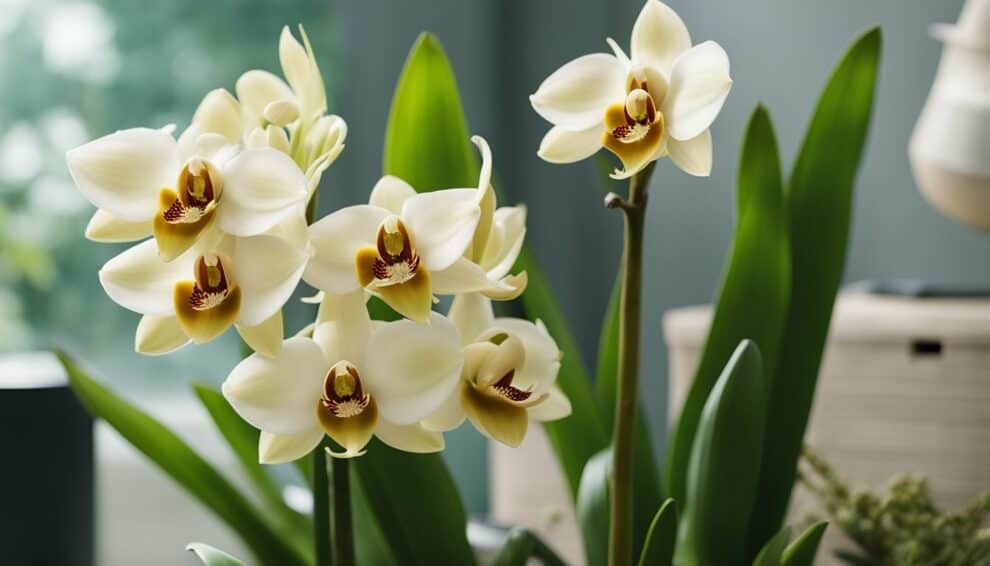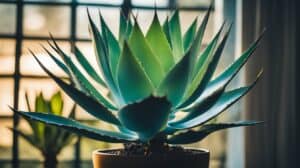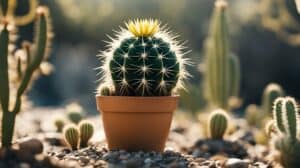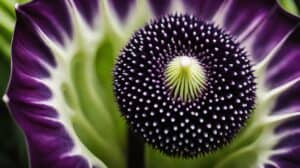Cymbidium Aloifolium, also known as the Aloe-leafed Cymbidium, is a stunning orchid species that is native to Southeast Asia.
This orchid is a popular choice among beginners due to its hardiness and easy care requirements.
In this article, we will explore the basics of Cymbidium Aloifolium care, including its preferred growing conditions, watering and fertilizing needs, and common pests and diseases.

To begin with, Cymbidium Aloifolium thrives in bright, indirect light and prefers temperatures between 60-80°F.
It is important to keep the orchid away from direct sunlight, as this can cause leaf burn.
The Aloe-leafed Cymbidium also requires a well-draining growing medium, such as bark or sphagnum moss, and should be repotted every 2-3 years to prevent overcrowding.
When it comes to watering, Cymbidium Aloifolium prefers to be kept evenly moist, but not waterlogged.
It is recommended to water the orchid once a week, or when the top inch of the growing medium feels dry to the touch.
Fertilizing should be done every 2-3 weeks during the growing season, using a balanced orchid fertilizer.
With proper care, Cymbidium Aloifolium can bloom for several months and provide a stunning addition to any orchid collection.
Understanding Cymbidium Aloifolium
Species Overview
Cymbidium Aloifolium is a species of orchid that belongs to the Cymbidium genus.
It is also known as the Aloe-leaved Cymbidium, and it is native to the Himalayas, Southeast Asia, and parts of China.
This species is a terrestrial orchid, which means that it grows on the ground instead of in trees.
It has long, narrow leaves that resemble those of the Aloe Vera plant and produces beautiful flowers that bloom in the winter and spring.
Cymbidium Aloifolium is a popular orchid species among beginners because it is easy to care for and can thrive in a range of growing conditions.
It is also a hardy plant that can tolerate cooler temperatures, making it an excellent choice for indoor gardeners.
Native Habitat
Cymbidium Aloifolium is native to a wide range of habitats, including grasslands, forests, and mountainous regions.
It can be found at elevations ranging from sea level to over 3000 meters.
In the wild, this orchid species grows in well-draining soil and receives plenty of sunlight.
When growing Cymbidium Aloifolium at home, it is essential to replicate its native habitat as closely as possible.
This means providing it with well-draining soil and ensuring that it receives plenty of sunlight.
It is also important to keep the plant at the right temperature and humidity levels to ensure that it thrives.
Overall, Cymbidium Aloifolium is an excellent choice for beginners who are interested in growing orchids.
With the right care and attention, this species can produce stunning flowers that will brighten up any home or garden.
Basic Orchid Care Requirements

Lighting Needs
Cymbidium Aloifolium orchids require bright but filtered light.
Direct sunlight can scorch their leaves, so it’s best to place them near a window with sheer curtains or behind a sheer shade.
If the leaves are turning yellow or brown, it may be a sign that the orchid is getting too much light.
Watering Schedule
Orchids should be watered once a week, but the frequency may vary depending on the environment. Before watering, make sure the top inch of the soil is dry.
Overwatering can lead to root rot, so it’s important to let the soil dry out between waterings.
It’s also important to use room temperature water and avoid getting water on the leaves or flowers.
Temperature and Humidity
Cymbidium Aloifolium orchids prefer temperatures between 60-80°F during the day and 50-60°F at night. They also require high humidity, around 50-70%.
To increase humidity, you can place a tray of water near the orchid or use a humidifier.
It’s important to avoid placing the orchid near air vents or drafts as they can dry out the plant.
Overall, Cymbidium Aloifolium orchids are relatively easy to care for as long as their basic needs are met.
With proper lighting, watering, temperature, and humidity, your orchid should thrive and produce beautiful blooms.
Potting and Repotting

Cymbidium Aloifolium is a beautiful orchid that requires proper potting and repotting to thrive.
In this section, we will discuss the key steps to potting and repotting this orchid.
Choosing the Right Soil
Choosing the right soil is essential for the growth and health of Cymbidium Aloifolium.
The best soil for this orchid is a well-draining mix that contains bark, perlite, and sphagnum moss.
This mix will provide the right balance of moisture and air circulation that the orchid needs to grow.
Pot Selection
Choosing the right pot is also important for the health of the orchid.
The pot should be large enough to accommodate the roots of the orchid and have adequate drainage holes to prevent waterlogging.
It is best to choose a pot made of clay or ceramic, as these materials will help regulate the temperature and moisture levels in the soil.
Repotting Steps
Repotting Cymbidium Aloifolium should be done every two to three years.
The best time to repot is in the spring, just before the orchid enters its active growth phase. Here are the steps for repotting:
- Gently remove the orchid from its current pot, being careful not to damage the roots.
- Remove any dead or damaged roots and trim the healthy roots back by about 1 inch.
- Place a layer of fresh soil in the bottom of the new pot.
- Position the orchid in the center of the pot and fill in the sides with fresh soil.
- Gently press down on the soil to secure the orchid in place.
- Water the orchid thoroughly, allowing the excess water to drain out of the bottom of the pot.
By following these simple steps, you can ensure that your Cymbidium Aloifolium orchid has the best chance to grow and thrive.
Maintenance and Troubleshooting

Fertilizing Routines
Cymbidium aloifolium orchids require regular fertilization to maintain healthy growth and blooming.
It is recommended to use a balanced orchid fertilizer with a ratio of 20-20-20, or a slow-release fertilizer with a 14-14-14 ratio.
Fertilize once a month during the growing season, which is usually from spring to fall. During the winter months, reduce fertilization to once every two months.
Be sure to follow the instructions on the fertilizer package and avoid over-fertilizing, as this can cause damage to the plant.
Pest and Disease Prevention
Prevention is key when it comes to pest and disease control for Cymbidium aloifolium orchids.
Regularly inspect the plant for any signs of pests, such as mealybugs, spider mites, or scale insects.
If any pests are found, isolate the plant and treat it with an appropriate insecticide.
To prevent the spread of disease, avoid overwatering and ensure proper air circulation around the plant.
It is also important to keep the growing area clean and free of debris.
Common Problems and Solutions
Cymbidium aloifolium orchids may encounter a variety of problems, including yellowing leaves, wilting, and root rot.
Yellowing leaves may be a sign of overwatering or nutrient deficiencies. To remedy this, adjust the watering schedule and fertilization routine accordingly.
Wilting may be caused by underwatering or root damage. Check the roots for any signs of damage or rot and adjust the watering schedule as needed.
Root rot is a common issue in orchids and can be caused by overwatering or poor drainage.
To prevent root rot, ensure proper drainage and avoid overwatering the plant.
If root rot is already present, remove any affected roots and repot the plant in fresh, well-draining soil.
Frequently Asked Questions

What type of potting mix should I use for my Cymbidium Aloifolium?
Cymbidium Aloifolium prefers a well-draining potting mix that is specifically formulated for orchids.
A mix that contains fir bark, sphagnum moss, and perlite is ideal.
Avoid using regular potting soil as it can retain too much moisture and suffocate the roots.
How often should I water my Cymbidium Aloifolium?
Cymbidium Aloifolium prefers to be kept moist but not soggy. Water the plant thoroughly and allow the excess water to drain out of the pot.
Wait until the top inch of the potting mix is dry before watering again.
In general, watering once a week is sufficient, but the frequency may vary depending on the humidity and temperature of the growing environment.
What are the best practices for Cymbidium Aloifolium care during winter?
During the winter months, Cymbidium Aloifolium requires cooler temperatures and reduced watering.
The plant should be kept in a location with temperatures between 50-60°F (10-15°C) and watered only when the potting mix is dry to the touch.
Fertilization should also be reduced or stopped during this time.
What are the ideal indoor conditions for growing a Cymbidium Aloifolium?
Cymbidium Aloifolium thrives in bright, indirect light and temperatures between 60-80°F (15-27°C).
It prefers a humid environment, so placing a tray of water near the plant or using a humidifier can be beneficial.
Adequate air circulation is also important to prevent fungal growth.
How can I encourage my Cymbidium Aloifolium to bloom again?
Cymbidium Aloifolium blooms in the late winter or early spring.
To encourage blooming, the plant should be exposed to cooler temperatures (50-60°F or 10-15°C) for several weeks in the fall.
Fertilization should also be increased during this time. Once flower spikes appear, avoid moving the plant as this can cause the buds to drop.
What is the typical growing season for a Cymbidium Aloifolium?
Cymbidium Aloifolium is a slow-growing orchid and can take several years to reach maturity.
It typically grows during the spring and summer months and enters a dormant period during the fall and winter.
With proper care, the plant can live for many years and produce beautiful blooms year after year.














